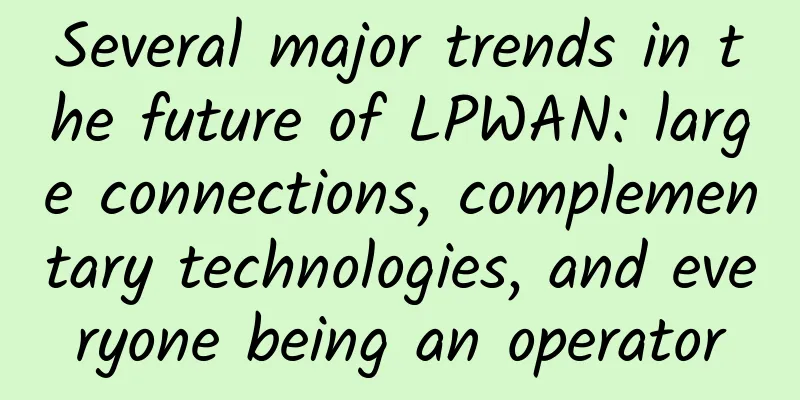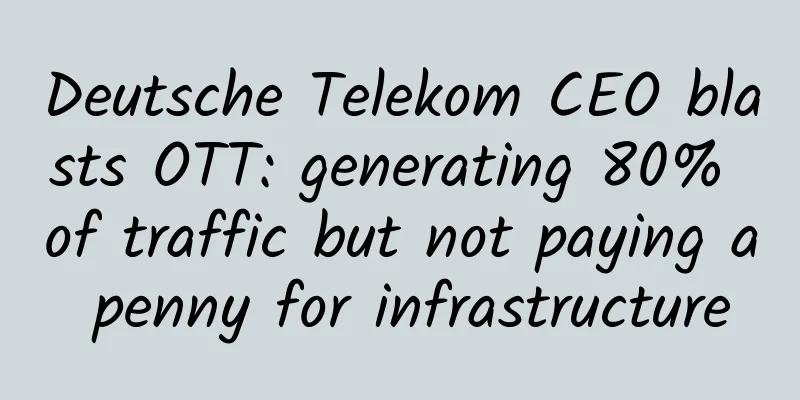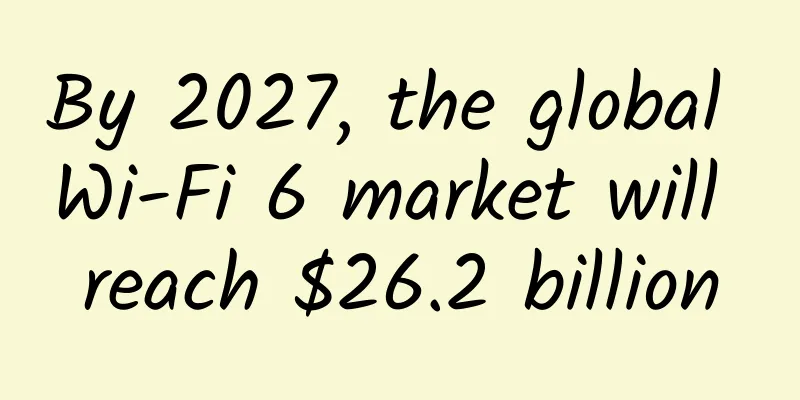Several major trends in the future of LPWAN: large connections, complementary technologies, and everyone being an operator

|
Although LPWAN has a history of several decades, it has only been in people's vision for about three years. During these three years, the industry has experienced many ups and downs, from a situation where hundreds of schools of thought contend to a situation where only a few mainstream technologies remain. Whether it is NB-IoT/eMTC based on licensed spectrum, or LoRa and Sigfox based on unlicensed spectrum, one of the main forces that eventually made them mainstream technologies is the formation of a huge global ecosystem. In addition, the LPWAN market will also present some new characteristics.
The number of LPWAN connections has increased significantly According to current data, the number of global cellular IoT connections mainly comes from traditional 2G/3G/4G. In the next seven years, traditional cellular networks will still carry a large number of IoT connections, but NB-IoT/eMTC will gradually surpass 2G/3G/4G to become the mainstream connection method. The latest forecast data released by GSMA is as follows: Global cellular IoT connections (millions; source: GSMA) According to GSMA's forecast data, by the end of 2018, the number of IoT terminals connected via 2G/3G/4G is expected to reach 694 million, and the number of terminals connected via NB-IoT/eMTC, which are based on licensed spectrum LPWAN technologies, is expected to reach 66 million, accounting for only 9%. By 2025, the number of 2G/3G/4G IoT connections will increase to 1.3 billion, while the number of NB-IoT/eMTC connections will increase to 1.8 billion. As traditional cellular networks still carry a large number of IoT connections, many applications that require high bandwidth require 3G/4G network connections, and the current 2G network industry chain is very mature and the cost is extremely low, 2G/3G/4G will still be one of the main carriers of cellular IoT connections in the next few years, but its growth rate is relatively slow, with a compound annual growth rate of only 9.38% from 2018 to 2025. NB-IoT/eMTC will grow faster as the industry chain matures, and will achieve an annual growth rate of more than 60% in the next few years, making its share of cellular IoT connections increase rapidly from 9% in 2018 to 58% in 2025, becoming the main carrier of cellular IoT connections. As for LoRa, due to its flexibility in network construction, the global industrial ecosystem has gradually matured. In the future, more companies will join the LoRa camp, especially for companies that want to become new operators in the era of the Internet of Things, they will be more enthusiastic about participating. According to data from the internationally renowned organization IHS Markit, the number of LoRa network connections was 32 million in 2017, and is expected to exceed 57 million in 2018 and reach 350 million in 2022. Compared with NB-IoT/eMTC, LoRa technology is more likely to be favored by non-traditional operators such as Internet companies and broadcasting operators. LoRa IoT Connection Forecast The situation of "one operator dominates" will change In the era of interpersonal communication services, there were only a few companies in each country as operators. The high barriers to entry made the market concentration in this field very high, shutting out other companies. After the demand for wide-area and mobile IoT applications emerged, telecom operators took on this role again, providing services to IoT users through their own cellular networks, and other companies were still unable to enter. However, the rise of various low-power wide area network technologies is breaking this pattern. From the current situation, it can be seen that the vendors providing low-power wide area network connection services are no longer the "privilege" of traditional telecom operators. Different network scales and business scopes have multiple new network "operators" participating in the market, forming a diversified pattern. Based on the characteristics of low-power networks, the situation where telecom operators dominate the market is changing. Diversified demands have led to the emergence of some different structures in the market, which can be roughly divided into two camps: operator-level and industry-level/enterprise-level. 1. Carrier-level camp Based on the global network coverage capability, the operator-level camp can quickly deploy a global low-power wide area network. At present, NB-IoT/eMTC has become the main choice for the core infrastructure of cellular IoT services of mainstream operators around the world. Before the emergence of LPWAN, operators with transnational networks were already providing global M2M IoT services to customers around the world. In the development of licensed spectrum LPWAN standards, operators and communication equipment manufacturers are active supporters and participants. Unlike the mobile Internet era, more companies can participate in the construction and application of low-power wide area networks, and some industries will no longer be monopolized. For example, in the chip industry, domestic and foreign companies such as Huawei HiSilicon, Qualcomm, MTK, ZTE Microelectronics, and Spreadtrum RDA are actively engaged in research and development and mass production. The value of the IoT industry chain is more concentrated in the platform and application layers. Therefore, when it is difficult to shake the market share of operators and communication equipment companies, providing vertical solutions is a good entry point. Of course, with their own advantages, operators and communication equipment companies are also working in this field. While technological progress and user demand have increased market capacity, they have also increased competition among participants. Leaders in various fields are penetrating the industry horizontally and vertically. 2. Industry-level/enterprise-level camp Unlike LPWANs dominated by telecom operators, unlicensed spectrum LPWAN networks rely more on market selection to survive. There are more than a dozen similar technologies in the world, but only a few can really succeed. The reasons can be summarized as the use of time, location, and people. The grasp of time windows, regional application expansion, and the creation of industrial ecology are all crucial. It can be foreseen that when faced with problems such as funding shortages and market expansion, most unlicensed spectrum LPWAN technologies will find it difficult to survive. For hardware companies such as modules, the gross profit margin is generally low, and small companies can easily be acquired by well-funded companies to form large-scale competitiveness. The flexibility of LoRa can bring more opportunities to the industry, and a large number of decentralized companies can participate in the operation of LoRa networks. However, this situation leads to a very fragmented and different standard results. Internet giants can take advantage of their cloud platform capabilities in this field and integrate these decentralized operator resources. Compared with telecom operators, LoRa can be deployed on demand and in a small area, but not all companies have the ability or need to build their own core network, network management, and billing systems. They can quickly realize network operations with the help of existing third-party cloud platforms. Each decentralized operator has a dedicated LoRaWAN standard specification for the access network, and uses the cloud platform provided by Internet giants after backhaul. The core network has unified specifications for this cloud platform, which guarantees the end-to-end standardization of the LoRa network to a certain extent. Since LoRa's core network, network management, and billing systems are guaranteed by Internet giants, a large system capable of handling ultra-large connected IoT networks can be formed. A large number of decentralized LoRa networks are entirely possible to form city-level coverage, of course, this is a gradual process. Complementarity between different technologies In general, whether it is the operator-level camp or the industry-level/enterprise-level camp, industry chain attributes such as chips, modules, terminals, communication equipment, platforms, applications, and organizations are indispensable. The differences lie in the market concentration, corporate composition, and the role played by various types of companies involved in each link. The operator-level camp can easily form global and regional low-power wide area networks, thanks to the inherent advantages of operators and policy support. Moreover, with the evolution of the market and the strong financial resources of operators, it is entirely possible to integrate a series of industrial chain links through acquisitions and other means, and eventually become a leader in the non-operator field. However, judging from the current communication network coverage, operators cannot cover all areas, such as harsh environments, remote areas, or complex environments like mines, where LPWAN is needed. In addition, for data security reasons, self-built networks are very applicable in many scenarios. LoRa is easily favored by users due to its flexible network layout. As we all know, the future LPWAN market will be presented in a diversified, long-tailed and customized way, and a large part of it will be supported by non-operator camps. The industry-level/enterprise-level camps will work harder to expand their own network in the world and regions, integrate various resources, and the advantages of the ecosystem will make the market advantages apparent, gradually developing from scenario-based and localized to regionalized. Of course, the competition between different technologies will become more intense. LoRa's diverse network construction modes With the active promotion of mainstream operators, equipment manufacturers and other industry giants as well as the international standards organization 3GPP, NB-IoT/eMTC can easily achieve large-scale, global coverage, focusing on the "big market". However, with the promotion of small and medium-sized enterprises and the rigid demand for personalized network construction, LoRa has been able to shine in various scene deployments, focusing on the "small market" and "long tail market". From the perspective of scale, due to the diversified and fragmented scene requirements, the long tail market will also occupy half of the market in the future. The two form a complementary relationship in the market, jointly improve the IoT network layer, and promote the rapid development of the IoT industry. The “Everyone Operator” model is promising As mentioned above, "operators" are no longer exclusive to telecom operators. As long as manufacturers own reusable assets (tangible products or intangible services) and charge multiple users for leasing them, they are operators of their assets. With the help of IoT technologies such as low-power wide area networks, "everyone can be an operator" becomes possible. Today, low-power wide-area network technologies such as NB-IoT/eMTC and LoRa are gaining ground around the world, and the networks they deploy all have the shadow of virtual operators. The degree of participation of these IoT network operators in telecom operations also varies. Relying on the flexibility of LoRa and the support of third-party network platforms, it can help companies quickly build networks and carry out network operations. Third-party platforms can help many operators build core networks and operation support systems (OSS), rather than just a platform for connection management and application enablement, thus forming some deeply involved operators; while some industry-level and enterprise-level LoRa networks mainly provide connections, and data is directly connected to the Internet, so the degree of participation of such operators is relatively shallow. For "product" operators, various types of product "operators" can manage and operate their products throughout their lifecycles, and provide various additional services based on the products. To become "operators", these manufacturers need the support of infrastructure technologies such as IoT communications and management platforms. Currently, there are a large number of manufacturers that provide these supporting technologies. Product operators can choose to build and operate these infrastructures themselves, or they can rent these facilities. Similar to different categories of virtual operators, product operators can have different depths of participation. As the Internet of Things penetrates deeper into our production and personal life, there will be more and more "operators" for various reusable products. They use the Internet of Things technology to supervise, operate, locate and bill the products they operate, forming various product "operators" with different degrees of participation. When LoRa and other IoT dedicated networks are gradually deployed around the world, and their supporting industrial chains mature, smaller organizations and even individuals begin to use these technologies to operate their assets, further lowering the threshold for various lightweight product "operators". One of the industrial changes brought about by the Internet of Things in the future is the group of product "operators" of various industries and sizes. Of course, the development of low-power wide area networks is also inseparable from the coordination of standards and industries. The establishment of standards can promote the development of the industry in an orderly and large-scale direction, and the progress of the industry will reversely affect the improvement of standards. The two are complementary and mutually reinforcing. In addition, some clear regulatory measures will be formed for low-power wide area networks in the future. Compared with the past process of allowing the market to develop freely, it is believed that orderly supervision will become the norm in the future, not only in the spectrum field, but also in data, platform and other fields. The era of supervision will also come. Of course, supervision is striving towards a fair market competition environment, rather than having obvious technical tendencies. |
<<: Top 10 edge computing vendors to watch
>>: Wireless charging has three constraints on market demand
Recommend
DigitalVM: 50% off on all VPS, 1-10Gbps unlimited traffic starting from $4/month in the US/Japan/Singapore
Digital-VM is a foreign VPS service provider esta...
Let’s talk about the Vrrp protocol?
[[374759]] This article is reprinted from the WeC...
5G is here! How long will it take for it to be truly universally adopted?
4G, the mobile network that allows us to make cal...
iWFHosting high-end server $189-Dual E5-2680v2, 192G memory, 4x2TB hard disk, 20TB monthly traffic
The tribe has always been mainly sharing low-pric...
Let's talk about network programming
Introduction 【1】Network programming: Computers di...
The next technology that will change the world, 5G, is ready
Throughout history, every social transformation, ...
IMIDC server restock: Hong Kong & Taiwan starting from $39/month / Japan server starting from $49/month
IMIDC (Rainbow Network) Hong Kong, Taiwan and Jap...
We need to look up to the stars (6G) and keep our feet on the ground (5G)
[[349140]] 2020 is coming to an end. With the adv...
Cross-industry cooperation becomes normalized, and China Telecom's business halls demonstrate their landmark attributes
In the era of mobile Internet, various new econom...
Run, AI! Huawei Cloud China Tour tells you the story of AI and applications going hand in hand
[51CTO.com original article] In fairy tales, when...
Maxthon Hosting Hong Kong CN2 Line VPS Simple Test
Aoyozhuji is also a long-established VPS hosting ...
[11.11] Tencent Cloud 2C2G4M cloud server starts at only 50 yuan/year, 2C4G6M cloud server only 100 yuan/year
Tencent Cloud has launched this year's 11.11 ...
AkkoCloud: San Jose/Germany/UK CN2 GIA, starting at 299 yuan per year, 300-600M bandwidth
AkkoCloud is a Chinese VPS hosting company founde...
You clearly have a 4G phone, but the operator still wants you to sign up for a 5G package?
According to data from the China Academy of Infor...
What does the all-out war on IPv6 mean for China's Internet?
[[238041]] Image source: Visual China IPv4. What ...









